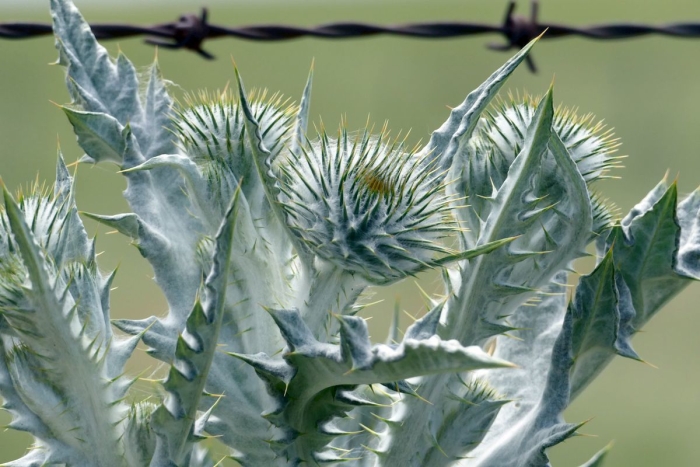Cotton Thistle
(Onopordum acanthium)
Cotton Thistle (Onopordum acanthium)
/
/

coenobita
CC BY 4.0
Image By:
coenobita
Recorded By:
Copyright:
CC BY 4.0
Copyright Notice:
Photo by: coenobita | License Type: CC BY 4.0 | License URL: http://creativecommons.org/licenses/by/4.0/ | Rights Holder: coenobita | Publisher: iNaturalist | Date Created: 2020-11-22T12:25:10-08:00 |


















Estimated Native Range
Summary
Onopordum acanthium, commonly known as cotton thistle or Scotch thistle, is a biennial herb native to temperate regions of Europe and Western Asia, including dry grasslands, roadsides, and disturbed soils. It has been widely naturalized in the United States and Australia. This plant can grow up to 10 feet tall and is characterized by its spiny, silver-gray leaves and conspicuous spiny-winged stems. Cotton thistle produces large, purple flower heads in its second year, typically blooming from June to August, which are highly attractive to bees and other pollinators.
Cotton thistle is valued for its striking architectural form and is sometimes used in gardens for its dramatic presence and ability to attract wildlife. However, it requires careful management due to its invasive potential outside its native range. It thrives in full sun and can tolerate a range of soil conditions, from poor to moderately fertile, as long as they are well-drained. Once established, it is drought-tolerant and requires minimal maintenance. In some regions, it is considered a noxious weed and is subject to control measures. Gardeners should be cautious of its sharp spines when handling and planting.CC BY-SA 4.0
Cotton thistle is valued for its striking architectural form and is sometimes used in gardens for its dramatic presence and ability to attract wildlife. However, it requires careful management due to its invasive potential outside its native range. It thrives in full sun and can tolerate a range of soil conditions, from poor to moderately fertile, as long as they are well-drained. Once established, it is drought-tolerant and requires minimal maintenance. In some regions, it is considered a noxious weed and is subject to control measures. Gardeners should be cautious of its sharp spines when handling and planting.CC BY-SA 4.0
Plant Description
- Plant Type: Herb
- Height: 3-9 feet
- Width: 1.5-3 feet
- Growth Rate: Slow, Moderate
- Flower Color: Purple
- Flowering Season: Spring, Summer
- Leaf Retention: Deciduous
Growth Requirements
- Sun: Full Sun
- Water: Medium
- Drainage: Fast, Medium, Slow
Common Uses
Bird Garden, Butterfly Garden
Natural Habitat
Temperate regions of Europe and Western Asia, including dry grasslands, roadsides, and disturbed soils
Other Names
Common Names: Scotch Thistle, Woolly Thistle
Scientific Names: , Onopordum acanthium, Acanos spina, Acanthium onopordon, Carduus acanthium, Onopordon acanthium, Onopordum acanthifolium, Onopordum acanthiifolium, Onopordum acanthium f. glabrescens, Onopordum acanthium f. glabrescente
GBIF Accepted Name: